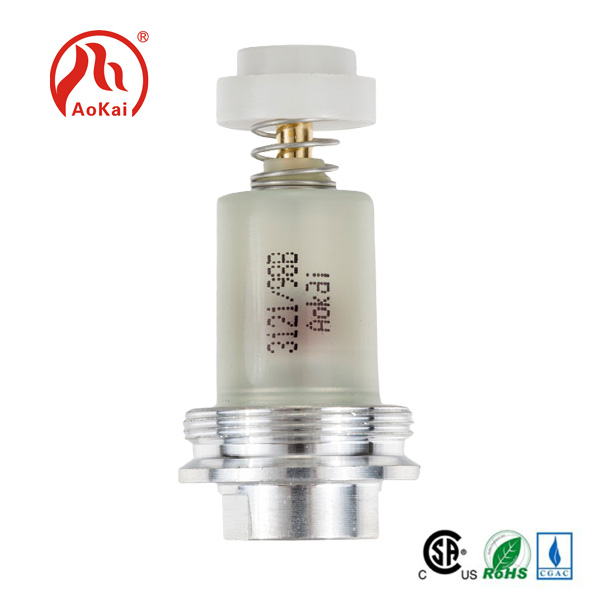Different types of solenoid valve
2021-11-25
Direct acting solenoid valve
Principle: when energized, the electromagnetic coil generates electromagnetic force to lift the closing part from the valve seat and open the valve; When the power is off, the electromagnetic force disappears, the spring presses the closing part on the valve seat, and the valve closes.
Features: it can work normally under vacuum, negative pressure and zero pressure, but the drift diameter is generally no more than 25mm.
Step by step direct acting solenoid valve
Principle: it is a combination of direct action and pilot type. When there is no pressure difference between the inlet and outlet, after power on, the electromagnetic force directly lifts the pilot small valve and the closing parts of the main valve up in turn, and the valve opens. When the inlet and outlet reach the start-up pressure difference, after being energized, the electromagnetic force pilot small valve will increase the pressure in the lower chamber of the main valve and decrease the pressure in the upper chamber, so as to push the main valve upward by using the pressure difference; In case of power failure, the pilot valve uses spring force or medium pressure to push the closing part downward to close the valve.
Features: it can also operate under zero differential pressure, vacuum and high pressure, but the power is large, so it must be installed horizontally.
Pilot operated solenoid valve
Principle: when energized, the electromagnetic force opens the pilot hole, the pressure in the upper chamber drops rapidly, forming a low and high pressure difference around the closing part, the fluid pressure pushes the closing part upward, and the valve opens; In case of power failure, the spring force closes the pilot hole, the inlet pressure quickly passes through the bypass hole, and the chamber forms a pressure difference between lower and upper around the valve closing part, and the fluid pressure pushes the closing part to move downward to close the valve.
Features: the upper limit of fluid pressure range is high, which can be installed arbitrarily (customized), but must meet the conditions of fluid pressure difference.
2. Solenoid valves are divided into six sub categories: direct acting diaphragm structure, step-by-step direct acting diaphragm structure, pilot diaphragm structure, direct acting piston structure, step-by-step direct acting piston structure and pilot piston structure.
3. Solenoid valves are classified according to their functions: water solenoid valve, steam solenoid valve, refrigeration solenoid valve, low-temperature solenoid valve, gas solenoid valve, fire solenoid valve, ammonia solenoid valve, gas solenoid valve, liquid solenoid valve, micro solenoid valve, pulse solenoid valve, hydraulic solenoid valve, normally open solenoid valve, oil solenoid valve, DC solenoid valve, high-pressure solenoid valve, explosion-proof solenoid valve, etc.

Principle: when energized, the electromagnetic coil generates electromagnetic force to lift the closing part from the valve seat and open the valve; When the power is off, the electromagnetic force disappears, the spring presses the closing part on the valve seat, and the valve closes.
Features: it can work normally under vacuum, negative pressure and zero pressure, but the drift diameter is generally no more than 25mm.
Step by step direct acting solenoid valve
Principle: it is a combination of direct action and pilot type. When there is no pressure difference between the inlet and outlet, after power on, the electromagnetic force directly lifts the pilot small valve and the closing parts of the main valve up in turn, and the valve opens. When the inlet and outlet reach the start-up pressure difference, after being energized, the electromagnetic force pilot small valve will increase the pressure in the lower chamber of the main valve and decrease the pressure in the upper chamber, so as to push the main valve upward by using the pressure difference; In case of power failure, the pilot valve uses spring force or medium pressure to push the closing part downward to close the valve.
Features: it can also operate under zero differential pressure, vacuum and high pressure, but the power is large, so it must be installed horizontally.
Pilot operated solenoid valve
Principle: when energized, the electromagnetic force opens the pilot hole, the pressure in the upper chamber drops rapidly, forming a low and high pressure difference around the closing part, the fluid pressure pushes the closing part upward, and the valve opens; In case of power failure, the spring force closes the pilot hole, the inlet pressure quickly passes through the bypass hole, and the chamber forms a pressure difference between lower and upper around the valve closing part, and the fluid pressure pushes the closing part to move downward to close the valve.
Features: the upper limit of fluid pressure range is high, which can be installed arbitrarily (customized), but must meet the conditions of fluid pressure difference.
2. Solenoid valves are divided into six sub categories: direct acting diaphragm structure, step-by-step direct acting diaphragm structure, pilot diaphragm structure, direct acting piston structure, step-by-step direct acting piston structure and pilot piston structure.
3. Solenoid valves are classified according to their functions: water solenoid valve, steam solenoid valve, refrigeration solenoid valve, low-temperature solenoid valve, gas solenoid valve, fire solenoid valve, ammonia solenoid valve, gas solenoid valve, liquid solenoid valve, micro solenoid valve, pulse solenoid valve, hydraulic solenoid valve, normally open solenoid valve, oil solenoid valve, DC solenoid valve, high-pressure solenoid valve, explosion-proof solenoid valve, etc.

Previous:The definition of the solenoid valve



